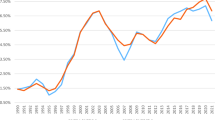Abstract
Detecting whether banks’ leverage is indeed procyclical is relevant to support the view that booms and crises may be reinforced by some sort of supply side financial accelerator, whilst finding a plausible explanation of banks’ behaviour is crucial to trace the road for a sensible reform of financial regulation and managers’ incentives. By analyzing a large sample of European banks, we show that procyclical leverage appears to be well entrenched in the behaviour of those banks for which investment banking prevails over the traditional commercial banking activity.
Similar content being viewed by others
References
Adrian T, Shin HS (2010a) Financial Intermediaries and Monetary Economics. In: Friedman B, Woodford M (eds) Hanbook of monetary economics, vol 3, Chap 12, pp 601–650
Adrian T, Shin HS (2010b) Liquidity and leverage. J Financial Intermed 19: 418–437
Andrews D, Monahan C (1992) An improved heteroskedasticity and autocorrelation consistent covariance matrix estimator. Econometrica 60: 953–966
Angelini P, Panetta F et al (2009) Financial sector procyclicality. Lessons from the crisis. Bank of Italy occasional Paper, no. 44
Basel Committee (2010a) Group of Governors and Heads of supervision announces higher global minimum capital standards. September, 2010
Basel Committee (2010b) Basel III: a global regulatory framework for more resilient banks and banking systems. December 2010
Beccalli E, Frantz P (2012) The determinants of mergers and acquisitions in banking. J Financial Serv Res. doi:10.1007/s10693-012-0138-y
Bernanke B, Blinder A (1988) Credit, money and aggregate demand. Am Econ Rev 78: 435–439
Bernanke B, Gertler M (1989) Agency costs, net worth, and business fluctuations. Am Econ Rev 79: 14–31
Brambor T, Clark W, Golder M (2006) Understanding interaction models: improving empirical analyses. Polit Anal 14: 63–82
Damar H, Meh C, Terajima Y (2010) Leverage, balance sheet size and wholesale funding. Bank of Canada WP 2010-39
D’Hulster K (2009) The leverage ratio (crisis response). Note n. 11, The World Bank
Focarelli D, Panetta F, Salleo C (2002) Why do banks merge?. J Money Credit Banking 34: 1047–1066
Geanakoplos J (2009) The leverage cycle. NBER Macroecon Ann 24: 1–65
Gertler M, Karadi P (2009) A model of unconventional monetary policy. New York University, mimeo
Gertler M, Kiyotaki N (2010) Financial intermediation and credit policy in business cycle analysis. In: Friedman B, Woodford M (eds) Hanbook of monetary economics, vol 3, Chap 11, pp 547–599
Gropp R, Heider F (2010) The determinants of bank capital structure. Rev Finance 14: 587–622
Johnston J, DiNardo J (1997) Econometric methods, 4th edn. McGraw Hill, New York
Kalemli-Ozcan S, Sorensen B, Yesiltas S (2011) Leverage across firms, banks and countries. NBER Working Paper 17354
Kiyotaki N, Moore J (1997) Credit cycles. J Polit Econ 105: 211–248
Meh C, Moran K (2008) The Role of Bank Capital in the Propagation of Shocks. Bank of Canada Working Paper 2008-36
Memmel C, Raupach P (2010) How do bank adjust their capital ratios?. J Financial Intermed 19: 509–528
Mimir Y (2010) Financial intermediaries, leverage ratios and business cycles. Mimeo
Pasiouras F, Tanna S, Gaganis C (2011) What drives acquisitions in the EU banking industry? The role of bank regulation and supervision framework, bank specific and market specific factors. Financial Mark Inst Instrum 20: 29–77
Piffer M (2010) Banks’ leverage dynamics: an empirical study, mimeo
Shin HS (2009) Comment on ‘The Leverage Cycle’ by John Geanakoplos. NBER Macroecon Ann 24: 75–84
Author information
Authors and Affiliations
Corresponding author
Rights and permissions
About this article
Cite this article
Baglioni, A., Beccalli, E., Boitani, A. et al. Is the leverage of European banks procyclical?. Empir Econ 45, 1251–1266 (2013). https://doi.org/10.1007/s00181-012-0655-4
Received:
Accepted:
Published:
Issue Date:
DOI: https://doi.org/10.1007/s00181-012-0655-4




